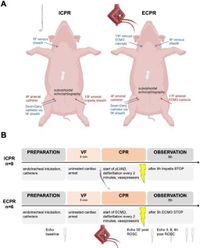In a pivotal study released on March 19, 2025, researchers explored the effectiveness of two mechanical circulatory support methods during cardiac arrest: extracorporeal cardiopulmonary resuscitation (ECPR) and intravascular CPR (ICPR) using an Impella device. This research aims to evaluate these techniques using a large animal model to determine their efficacy during life-threatening cardiac events.
The experiment involved 14 juvenile female German landrace pigs, which were subjected to electrically induced cardiac arrest for five minutes. Post-arrest, the pigs received either ECPR, which utilizes veno-arterial extracorporeal membrane oxygenation (VA-ECMO), or ICPR using the Impella ECP device. Researchers monitored the animals for five hours following the return of spontaneous circulation (ROSC) to assess the comparative effectiveness of these interventions.
One of the critical findings revealed that while ECPR successfully facilitated ROSC in all six animals treated, ICPR led to ROSC in six of the eight pigs, a difference that was not statistically significant (p = 0.19). Following resuscitation, echocardiographic evaluations indicated no notable differences in left ventricular (LV) or right ventricular (RV) function between the two treatment groups. Specifically, LV-global longitudinal strain values three hours post-ROSC averaged -16.5 ± 5.6% for ICPR and -13.7 ± 5.9% for ECPR, yielding a non-significant p-value of 0.99.
These findings suggest that both methods effectively provide haemodynamic support during cardiac arrest and after ROSC. Notably, researchers highlighted that while ECPR required a longer cannulation time—averaging 469 seconds versus only 153 seconds for the Impella device—both approaches facilitated a similar recovery of cardiac function.
Mechanical circulatory support is increasingly recognized as a vital response during cardiac arrest, particularly as more practitioners adopt ECPR. Prior investigations indicated that ECPR may yield favorable outcomes, leading to improved rates of survival and neurological function in selected patients. However, the study's results indicate that ICPR offers a less invasive alternative with comparable immediate outcomes.
This study sheds light on the potential advantages of each method. ECPR, while effective, may impose some risks, such as limb ischemia, which occurred in one of the ECPR-treated animals. In contrast, the ICPR method, requiring a single vascular access point with a smaller introducer sheath, could reduce complication rates, although this data needs further validation.
Both methods demonstrated the ability to increase coronary perfusion pressure, a significant factor in the success of resuscitation, yet the researchers noted that although vascular access for ECPR was more complicated, effective resuscitation outcomes were achieved for both interventions. Therefore, clinicians may need to weigh the benefits of faster deployment and reduced complication potential of ICPR against the established use of ECPR, particularly in emergency settings.
One striking conclusion from this study is the evident need for ongoing research to better determine patient selection criteria for these devices and to identify scenarios in which one method may yield significant advantages over the other.
As the landscape of cardiac arrest treatment evolves, findings like these pave the way for optimizing mechanical circulatory support strategies, ultimately aiming to improve survival rates and outcomes for patients in critical conditions. The continued exploration into these promising avenues may foster advancements that could redefine responses to such emergencies.
In summary, the comparative research on ECPR and ICPR establishes a foundation for future investigations that could refine cardiac arrest interventions, helping to ensure robust treatment pathways that enhance patient care and recovery in critical situations.




